Microstructure, Mechanical and Tribological Properties of Arc Ion Plating NbN-Based Nanocomposite Films
Abstract
:1. Introduction
2. Materials and Methods
2.1. Film Deposition
2.2. Characterization and Tribological Tests
3. Results and Discussion
3.1. Microstructures and Mechanical Properties
3.2. Frictional Wear Properties and Wear Mechanisms
4. Conclusions
- (1)
- The NbN film was stoichiometric, while the contents of Ag in the NbN-Ag and NbN/NbN-Ag films were 20.11 and 9.07 at.%, respectively. The NbN film exhibited superior mechanical properties, while the NbN-Ag film had low hardness and poor adhesive strength due to the fact that the Ag existed in a separate phase in the film interior and possessed low hardness. However, the mechanical properties of NbN-Ag film were significantly improved by designing the NbN/NbN-Ag multilayer structure.
- (2)
- The introduction of Ag into the NbN film can effectively reduce the friction coefficient but significantly increase the wear loss. In contrast to the NbN-Ag film, the higher friction and lower wear loss of NbN/NbN-Ag film were mainly ascribed to its relatively lower Ag content and superior mechanical properties, respectively. The results show that the main wear mechanisms of NbN and NbN/NbN-Ag films were adhesive and oxidation wear with slight abrasive wear, while the severe abrasive and oxidation wear dominated the wear mechanism of NbN-Ag films.
- (3)
- The NbN/NbN-Ag multilayer film could be a promising alternative for NbN-Ag film to prolong the service life of the film both at room and elevated temperatures, depending on its excellent mechanical properties, wear resistance and excellent lubrication effect of Nb2O5 and AgNbO3.
Author Contributions
Funding
Institutional Review Board Statement
Informed Consent Statement
Data Availability Statement
Acknowledgments
Conflicts of Interest
References
- Ou, Y.X.; Lin, J.; Tong, S.; Che, H.L.; Sproul, W.D.; Lei, M.K. Wear and corrosion resistance of CrN/TiN superlattice coatings deposited by a combined deep oscillation magnetron sputtering and pulsed dc magnetron sputtering. Appl. Surf. Sci. 2015, 351, 332–343. [Google Scholar] [CrossRef]
- Wu, Z.; Zhou, F.; Chen, K.; Wang, Q.; Zhou, Z.; Yan, J.; Li, L.K.-Y. Friction and wear properties of CrSiCN coatings with low carbon content as sliding against SiC and steel balls in water. Tribol. Int. 2016, 94, 176–186. [Google Scholar] [CrossRef]
- Melnikova, G.; Kuznetsova, T.; Lapitskaya, V.; Petrovskaya, A.; Chizhik, S.; Zykova, A.; Safonov, V.; Aizikovich, S.; Sadyrin, E.; Sun, W.; et al. Nanomechanical and nanotribological properties of nanostructured coatings of tantalum and Its compounds on steel substrates. Nanomaterials 2021, 11, 2407. [Google Scholar] [CrossRef] [PubMed]
- Podgornik, B.; Sedlaček, M.; Mandrino, D. Performance of CrN coatings under boundary lubrication. Tribol. Int. 2016, 96, 247–257. [Google Scholar] [CrossRef]
- Chen, L.; Ran, Y.; Jiang, Z.; Li, Y.; Wang, Z. Structural, compositional, and plasmonic characteristics of Ti–Zr ternary nitride thin films tuned by the nitrogen flow ratio in magnetron sputtering. Nanomaterials 2020, 10, 829. [Google Scholar] [CrossRef] [PubMed]
- Zhang, Z.; Zhang, L.; Yuan, H.; Qiu, M.; Zhang, X.; Liao, B.; Zhang, F.; Ouyang, X. Tribological behaviors of super-hard TiAlN coatings deposited by filtered cathode vacuum arc deposition. Materials 2022, 15, 2236. [Google Scholar] [CrossRef] [PubMed]
- Zin, V.; Montagner, F.; Deambrosis, S.M.; Mortalò, C.; Litti, L.; Meneghetti, M.; Miorin, E. Mechanical and tribological properties of Ta-N and Ta-Al-N coatings deposited by reactive high power impulse magnetron sputtering. Materials 2022, 15, 3354. [Google Scholar] [CrossRef]
- Musil, J. Hard and superhard nanocomposite coatings. Surf. Coat. Technol. 2000, 125, 322–330. [Google Scholar] [CrossRef]
- Aouadi, S.M.; Paudel, Y.; Luster, B.; Stadler, S.; Kohli, P.; Muratore, C.; Hager, C.; Voevodin, A.A. Adaptive Mo2N/MoS2/Ag Tribological Nanocomposite Coatings for Aerospace Applications. Tribol. Lett. 2008, 29, 95–103. [Google Scholar] [CrossRef]
- Chen, F.; Feng, Y.; Shao, H.; Zhang, X.; Chen, J.; Chen, N. Friction and Wear Behaviors of Ag/MoS2/G Composite in Different Atmospheres and at Different Temperatures. Tribol. Lett. 2012, 47, 139–148. [Google Scholar] [CrossRef]
- Aouadi, S.M.; Singh, D.P.; Stone, D.S.; Polychronopoulou, K.; Nahif, F.; Rebholz, C.; Muratore, C.; Voevodin, A.A. Adaptive VN/Ag nanocomposite coatings with lubricious behavior from 25 to 1000 °C. Acta Mater. 2010, 58, 5326–5331. [Google Scholar] [CrossRef]
- Stone, D.S.; Migas, J.; Martini, A.; Smith, T.; Muratore, C.; Voevodin, A.A.; Aouadi, S.M. Adaptive NbN/Ag coatings for high temperature tribological applications. Surf. Coat. Technol. 2012, 206, 4316–4321. [Google Scholar] [CrossRef]
- Sandu, C.S.; Benkahoul, M.; Parlinska-Wojtan, M.; Sanjinés, R.; Lévy, F. Morphological, structural and mechanical properties of NbN thin films deposited by reactive magnetron sputtering. Surf. Coat. Technol. 2006, 200, 6544–6548. [Google Scholar]
- Bendavid, A.; Martin, P.J.; Kinder, T.J.; Preston, E.W. The deposition of NbN and NbC thin films by filtered vacuum cathodic arc deposition. Surf. Coat. Technol. 2003, 163, 347–352. [Google Scholar] [CrossRef]
- Mulligan, C.P.; Blanchet, T.A.; Gall, D. CrN–Ag nanocomposite coatings: Effect of growth temperature on the microstructure. Surf. Coat. Technol. 2008, 203, 584–587. [Google Scholar] [CrossRef]
- Bondarev, A.V.; Kiryukhantsev-Korneev, P.V.; Levashov, E.A.; Shtansky, D.V. Tribological behavior and self-healing functionality of TiNbCN-Ag coatings in wide temperature range. Appl. Surf. Sci. 2017, 396, 110–120. [Google Scholar] [CrossRef]
- Voevodin, A.; Zabinski, J. Nanocomposite and nanostructured tribological materials for space applications. Compos. Sci. Technol. 2005, 65, 741–748. [Google Scholar] [CrossRef]
- Hsieh, J.H.; Chiu, C.H.; Li, C.; Wu, W.; Chang, S.Y. Development of anti-wear and anti-bacteria TaN-(Ag,Cu) thin films—A review. Surf. Coat. Technol. 2013, 233, 159–168. [Google Scholar] [CrossRef]
- Wu, Y.; Chen, J.; Li, H.; Ji, L.; Ye, Y.; Zhou, H. Preparation and properties of Ag/DLC nanocomposite films fabricated by unbalanced magnetron sputtering. Appl. Surf. Sci. 2013, 284, 165–170. [Google Scholar] [CrossRef]
- Bondarev, A.V.; Kiryukhantsev-Korneev, P.V.; Sidorenko, D.A.; Shtansky, D.V. A new insight into hard low friction MoCN–Ag coatings intended for applications in wide temperature range. Mater. Des. 2016, 93, 63–72. [Google Scholar] [CrossRef]
- Ju, H.; Xu, J. Microstructure and tribological properties of NbN-Ag composite films by reactive magnetron sputtering. Appl. Surf. Sci. 2015, 355, 878–883. [Google Scholar] [CrossRef]
- Ren, P.; Zhang, K.; He, X.; Du, S.; Yang, X.; An, T.; Wen, M.; Zheng, W. Toughness enhancement and tribochemistry of the Nb-Ag-N films actuated by solute Ag. Acta Mater. 2017, 137, 1–11. [Google Scholar] [CrossRef]
- Ju, H.; Ding, N.; Xu, J.; Yu, L.; Geng, Y.; Ahmed, F. The tribological behavior of niobium nitride and silver composite films at elevated testing temperatures. Mater. Chem. Phys. 2019, 237, 121840. [Google Scholar] [CrossRef]
- Ren, Y.; Jia, J.; Cao, X.; Zhang, G.; Ding, Q. Effect of Ag contents on the microstructure and tribological behaviors of NbN–Ag coatings at elevated temperatures. Vacuum 2022, 204, 111330. [Google Scholar] [CrossRef]
- Dai, X.; Wen, M.; Wang, J.; Cui, X.; Wang, X.; Zhang, K. The tribological performance at elevated temperatures of MoNbN-Ag coatings. Surf. Coat. Technol. 2020, 509, 145372. [Google Scholar] [CrossRef]
- Mulligan, C.P.; Gall, D. CrN–Ag self-lubricating hard coatings. Surf. Coat. Technol. 2005, 200, 1495–1500. [Google Scholar] [CrossRef]
- Smyrnova, K.; Sahul, M.; Harsani, M.; Pogrebnjak, A.; Ivashchenko, V.; Beresnev, V.; Stolbovoy, V.; Caplovic, L.; Caplovicova, M.; Vanco, L.; et al. Microstructure, mechanical and tribological properties of advanced layered WN/MeN (Me = Zr, Cr, Mo, Nb) nanocomposite coatings. Nanomaterials 2022, 12, 395. [Google Scholar] [CrossRef]
- Xu, F.; Xu, J.H.; Yuen, M.F.; Zheng, L.; Lu, W.Z.; Zuo, D.W. Adhesion improvement of diamond coatings on cemented carbide with high cobalt content using PVD interlayer. Diam. Relat. Mater. 2013, 34, 70–75. [Google Scholar] [CrossRef]
- Singh, K.; Bidaye, A.C.; Suri, A.K. Magnetron Sputtered NbN Films with Nb Interlayer on Mild Steel. Int. J. Corros. 2011, 2011, 748168. [Google Scholar] [CrossRef] [Green Version]
- Lin, J.; Moore, J.J.; Mishra, B.; Pinkas, M.; Zhang, X.; Sproul, W.D. CrN/AlN superlattice coatings synthesized by pulsed closed field unbalanced magnetron sputtering with different CrN layer thicknesses. Thin Solid Films 2009, 517, 5798–5804. [Google Scholar] [CrossRef]
- Leyland, A.; Matthews, A. On the significance of the H/E ratio in wear control: A nanocomposite coating approach to optimised tribological behaviour. Wear 2000, 246, 1–11. [Google Scholar] [CrossRef]
- Wang, C.; Shi, K.; Gross, C.; Pureza, J.M.; de Mesquita Lacerda, M.; Chung, Y.-W. Toughness enhancement of nanostructured hard coatings: Design strategies and toughness measurement techniques. Surf. Coat. Technol. 2014, 257, 206–212. [Google Scholar] [CrossRef]
- Guan, X.; Wang, Y.; Zhang, G.; Jiang, X.; Wang, L.; Xue, Q. Microstructures and properties of Zr/CrN multilayer coatings fabricated by multi-arc ion plating. Tribol. Int. 2017, 106, 78–87. [Google Scholar] [CrossRef]
- Bondarev, A.V.; Golizadeh, M.; Shvyndina, N.V.; Shchetinin, I.V.; Shtansky, D.V. Microstructure, mechanical, and tribological properties of Ag-free and Ag-doped VCN coatings. Surf. Coat. Technol. 2017, 331, 77–84. [Google Scholar] [CrossRef]
- Wu, F.; Yu, L.; Ju, H.; Asempah, I.; Xu, J. Structural, mechanical and tribological properties of NbCN-Ag nanocomposite films deposited by reactive magnetron Sputtering. Coatings 2018, 8, 50. [Google Scholar] [CrossRef] [Green Version]
- Hu, J.J.; Muratore, C.; Voevodin, A.A. Silver diffusion and high-temperature lubrication mechanisms of YSZ–Ag–Mo based nanocomposite coatings. Compos. Sci. Technol. 2007, 67, 336–347. [Google Scholar] [CrossRef]
- Mulligan, C.P.; Blanchet, T.A.; Gall, D. Control of lubricant transport by a CrN diffusion barrier layer during high-temperature sliding of a CrN–Ag composite coating. Surf. Coat. Technol. 2010, 205, 1350–1355. [Google Scholar] [CrossRef]




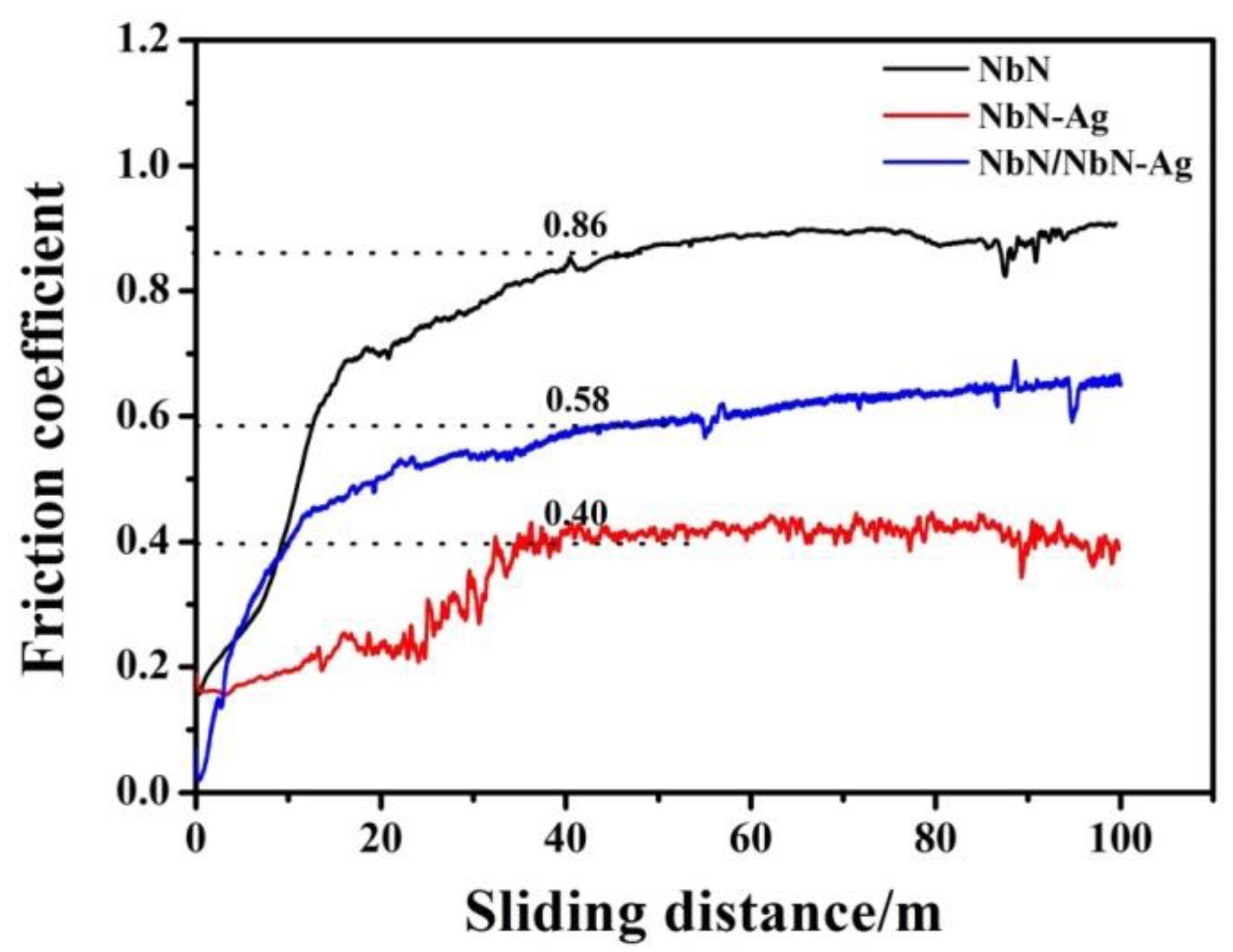
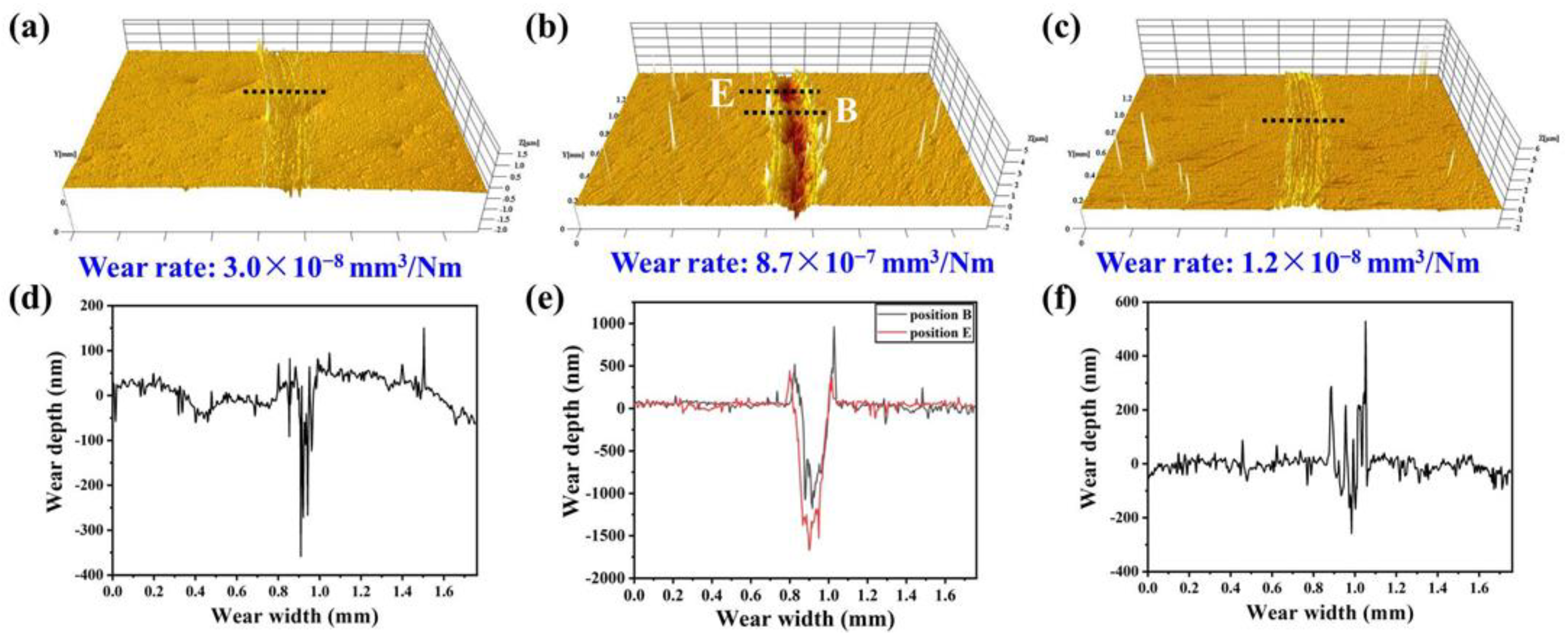
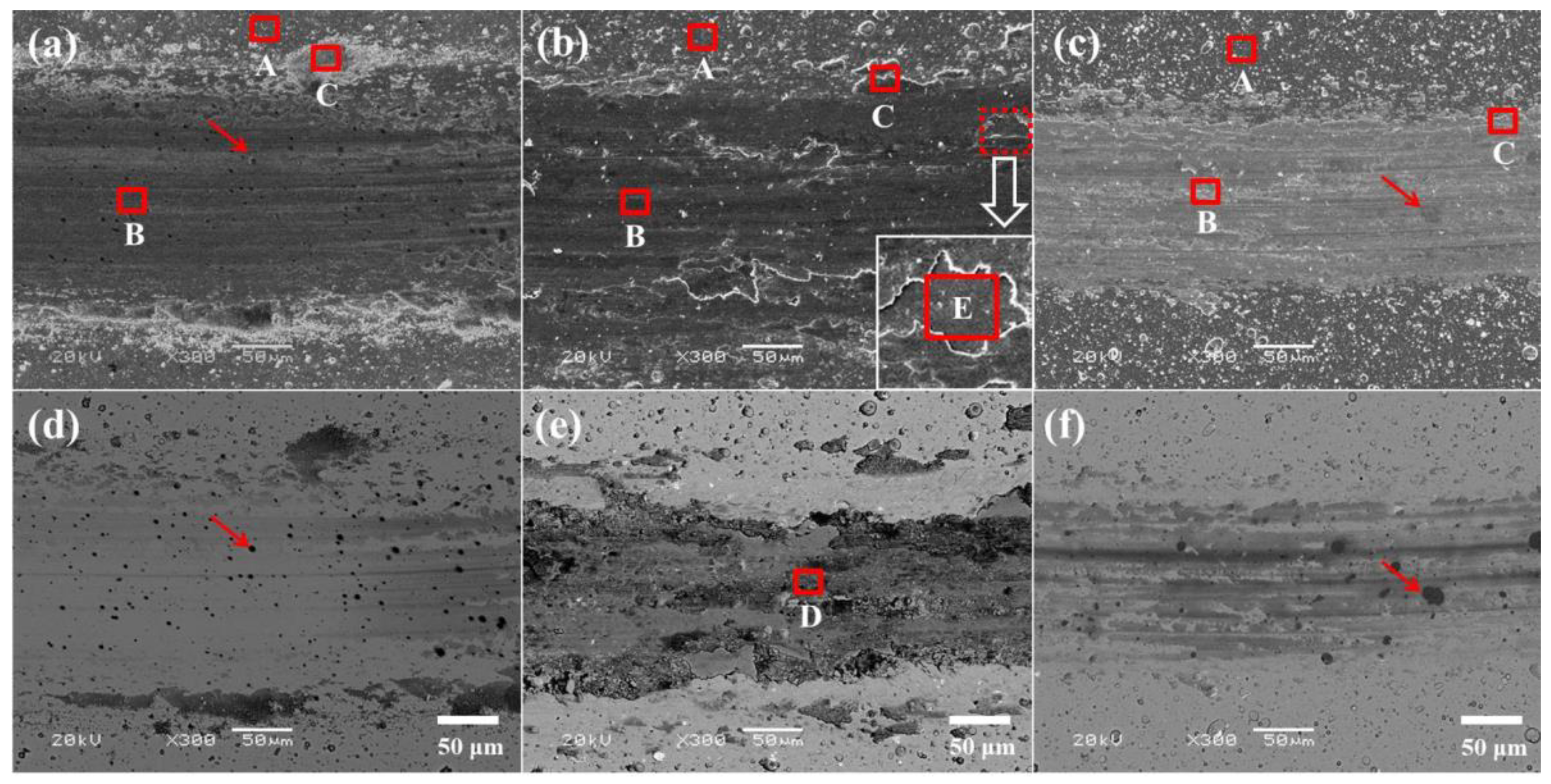
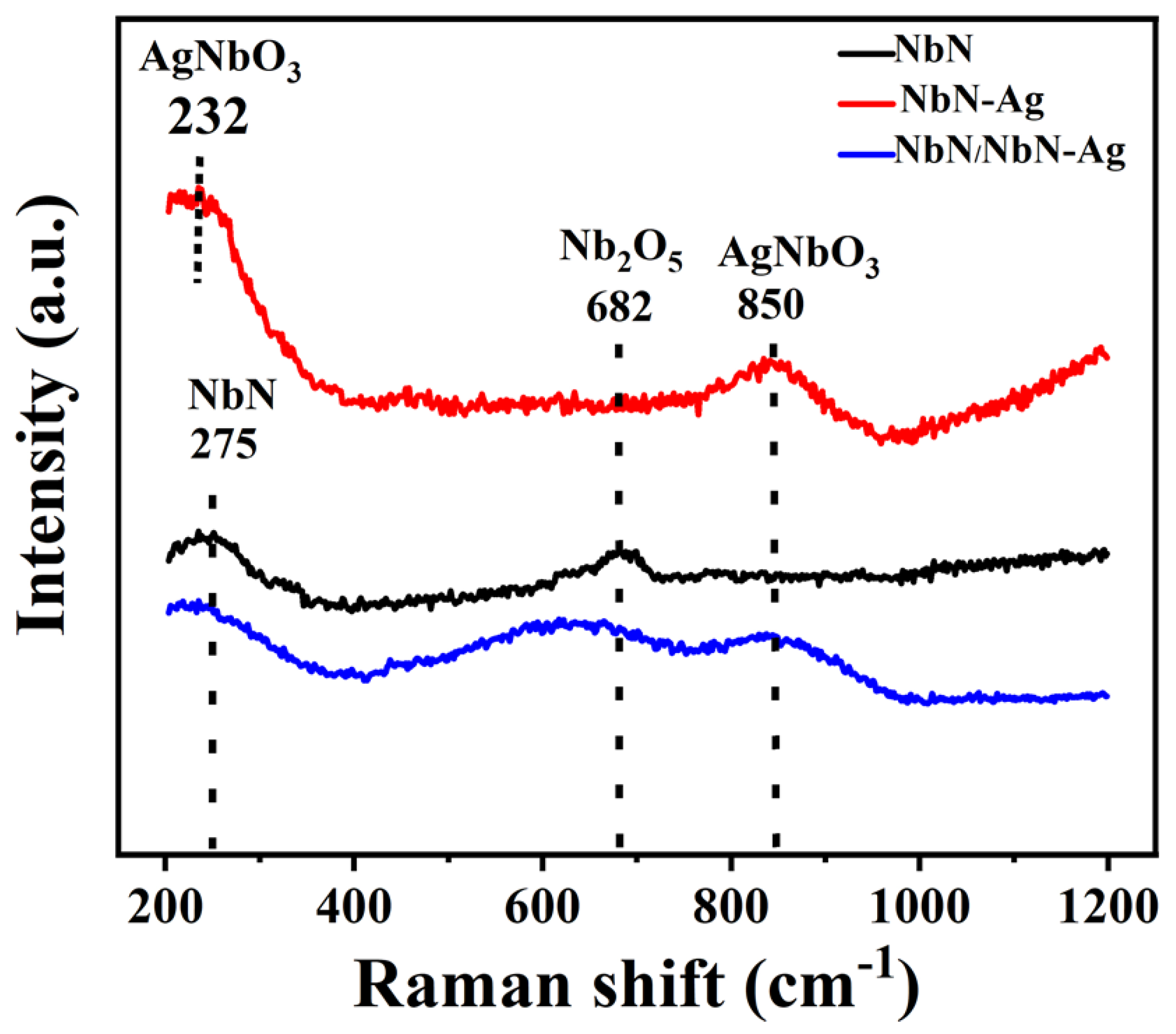

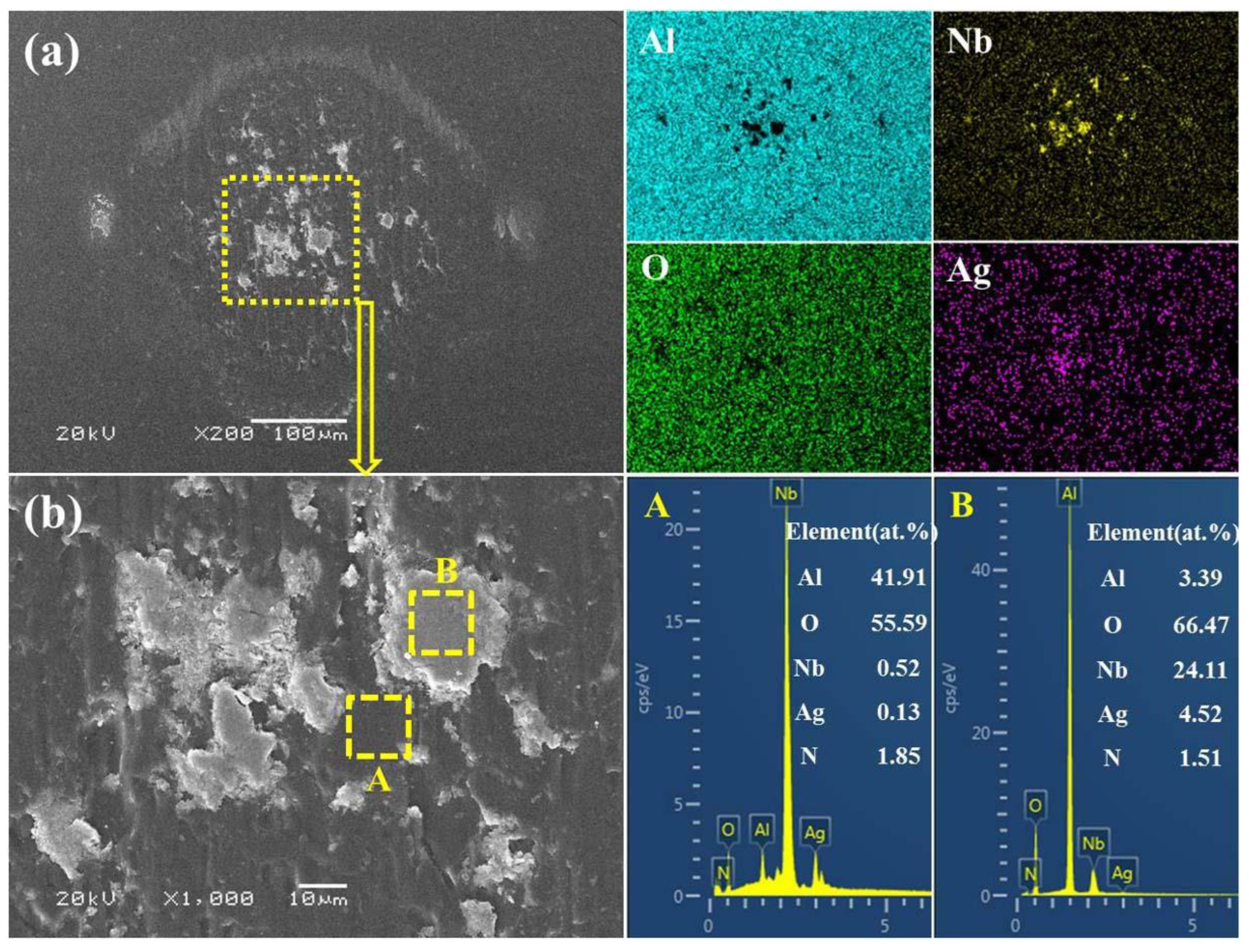
| Parameters | Value | |
|---|---|---|
| Working pressure (Pa) | 0.42 | |
| Chamber temperature (°C) | 150 | |
| Ar:N2 ratio (sccm) | 65:500 | |
| Duty cycle (%) | 40 | |
| Nb target current (A) | 135 | |
| Ag target current (A) | 50 | |
| Negative dc pulse bias (−V) | 200 | |
| Deposition time (min) | NbN | 110 |
| NbN-Ag | 105 | |
| NbN/NbN-Ag | 110 (5/5) | |
| Mechanical properties | NbN | NbN-Ag | NbN/NbN-Ag |
|---|---|---|---|
| Hardness (H, GPa) | 44.0 | 9.7 | 19.8 |
| Elastic modulus (E*, GPa) | 477.6 | 181.9 | 291.3 |
| H/E* | 0.092 | 0.053 | 0.068 |
| H3/E*2 (GPa) | 0.372 | 0.027 | 0.092 |
| Critical load (Lc1, N) | 34.6 | 6.4 | 15.8 |
| Film | NbN | NbN-Ag | NbN/NbN-Ag | ||||||||
|---|---|---|---|---|---|---|---|---|---|---|---|
| Region | A | B | C | A | B | C | D | E | A | B | C |
| Nb (at.%) | 50.04 ± 1.32 | 47.14 ± 1.39 | 44.61 ± 1.89 | 29.19 ± 1.33 | 42.68 ± 2.02 | 39.32 ± 1.47 | 44.02 ± 1.67 | 10.10 ± 1.85 | 43.22 ± 1.73 | 45.32 ± 1.82 | 51.34 ± 1.33 |
| N (at.%) | 49.96 ± 1.32 | 31.35 ± 1.47 | - | 45.37 ± 1.46 | 7.87 ± 1.57 | 9.01 ± 1.51 | 6.38 ± 2.10 | - | 47.10 ± 2.33 | 0.95 ± 0.51 | 1.02 ± 0.55 |
| Ag (at.%) | - | - | - | 21.84 ± 1.22 | 10.12 ± 1.63 | 23.46 ± 2.01 | 11.89 ± 1.67 | - | 9.68 ± 2.18 | 9.19 ± 1.42 | 11.02 ± 1.10 |
| O (at.%) | - | 21.51 ± 1.61 | 54.63 ± 1.34 | 3.60 ± 1.21 | 23.32 ± 1.56 | 26.19 ± 1.28 | 20.82 ± 1.28 | 51.71 ± 2.24 | - | 43.10 ± 1.09 | 35.41 ± 2.10 |
| Al (at.%) | - | - | 0.76 ± 1.51 | - | - | - | - | - | - | 1.44 ± 0.76 | 1.21 ± 0.77 |
| Cr (at.%) | - | - | - | - | 3.51 ± 1.22 | - | 4.05 ± 0.91 | 8.78 ± 1.77 | - | - | - |
| Fe (at.%) | - | - | - | - | 3.64 ± 1.01 | - | 3.86 ± 0.87 | 8.95 ± 1.68 | - | - | - |
| Ni (at.%) | - | - | - | - | 8.86 ± 1.79 | 2.02 ± 1.36 | 8.98 ± 1.66 | 20.46 ± 1.45 | - | - | - |
Publisher’s Note: MDPI stays neutral with regard to jurisdictional claims in published maps and institutional affiliations. |
© 2022 by the authors. Licensee MDPI, Basel, Switzerland. This article is an open access article distributed under the terms and conditions of the Creative Commons Attribution (CC BY) license (https://creativecommons.org/licenses/by/4.0/).
Share and Cite
Fu, Y.; Li, H.; Chen, J.; Guo, H.; Wang, X. Microstructure, Mechanical and Tribological Properties of Arc Ion Plating NbN-Based Nanocomposite Films. Nanomaterials 2022, 12, 3909. https://doi.org/10.3390/nano12213909
Fu Y, Li H, Chen J, Guo H, Wang X. Microstructure, Mechanical and Tribological Properties of Arc Ion Plating NbN-Based Nanocomposite Films. Nanomaterials. 2022; 12(21):3909. https://doi.org/10.3390/nano12213909
Chicago/Turabian StyleFu, Yingying, Hongxuan Li, Jianmin Chen, Hongjian Guo, and Xiang Wang. 2022. "Microstructure, Mechanical and Tribological Properties of Arc Ion Plating NbN-Based Nanocomposite Films" Nanomaterials 12, no. 21: 3909. https://doi.org/10.3390/nano12213909





